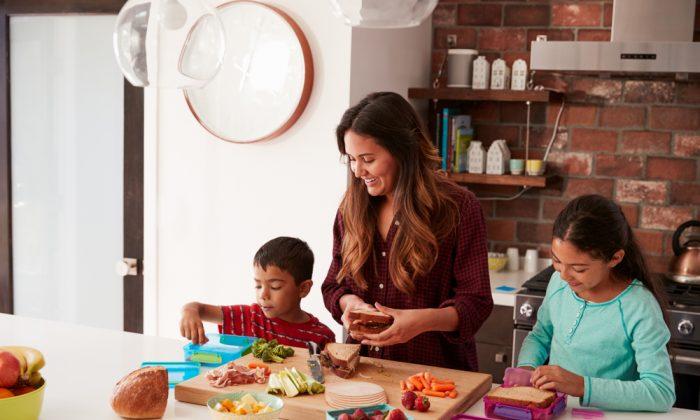School lunches and snacks play a large part in the school year routine. It can be challenging for parents to ensure that the food they’re packing for their children best meets their nutritional needs. With so many conflicting ideas about nutrition today, it can be difficult to determine what qualifies as “good for you.”
I asked nutrition expert Nicole Magryta, author of “Nourish Your Tribe: Empowering Parents to Grow Strong, Smart, Successful Kids” for advice on packing lunches, snacks, and even navigating the offerings in the school cafeteria. Here’s what she said.
In order to meet this goal, we need to focus our attention on nourishment. A healthy school lunch should include foods that satiate, provide essential nutrients, and balance blood sugars.
This includes quality protein like chicken, turkey, fish, hard boiled eggs, beans, or lentils; vegetables like carrots, cucumbers, red peppers, pickles, sweet potatoes, or leafy greens; fresh or frozen fruits like apples, berries, watermelon, bananas, or kiwi; whole grains like rice, quinoa, oats, or buckwheat; and healthy fats like nuts, seeds, nut or seed butters, avocados, or olives.
When it comes to beverages, it’s important to avoid packing sugary drinks like soda, Gatorade, or juice in lunch boxes and instead stick with a refillable water bottle.
If parents don’t see food as a critical component to optimal brain function and emotional and physical growth, then lunch boxes will reflect this misunderstanding.
Unfortunately, our fast-paced lifestyles have led to sacrificing health for convenience. The volume of processed, packaged convenience foods that are placed in lunchboxes have left our kids nutrient-deficient and vulnerable to cognitive issues that can negatively affect learning, memory, and concentration. Many of these items include a plethora of sweet treats, savory snacks packed with inflammatory fats and refined white flours, and sugary drinks.
We of course want our kids to enjoy their lunches, but we must get away from the idea that our kids need a cookie or a sweet treat packed in every lunch box. As a parent, do you eat sweets with every meal? Hopefully your answer is no. Why then, do we want to teach our kids that this pattern of eating is healthy or will set them up for success? Teaching children good nutrition empowers them with the wisdom to thrive and to be aware of their body’s voice.
While both adults and children need the same types of nutrients—vitamins, minerals, proteins, carbs, and fat—the required amounts of each are different and change as children grow. For example, per 100 kcal of food, a breast-fed infant at six to eight months of age needs nine times as much iron and four times as much zinc as an adult male. In addition, children under 5 (especially infants) need at least 30-40 percent of their calories from fat, while older children need around 25–35 percent.
Fast forward to puberty, which accounts for another period of rapid growth, children’s macro and micronutrient needs increase specifically for critical nutrients such as protein, iron, calcium, zinc, and folate.
Keep it familiar. Lunchboxes are not a time to try new foods. Kids have limited time to eat and familiar items will encourage eating.
Bento-style lunch containers often help with organizing key foods—protein, veggies, fruit, and healthy fiber-rich carbs.
Plan what you are packing the night before—or better yet, for the week—to help with busy mornings. Get your kids involved with the packing and planning process. Pack and prep as much as you can ahead of time. Cut up veggies, wash and chop lettuce, slice apples (with a squeeze of lemon juice to prevent browning), etc. Fill little containers with yogurt, nut butter (or sunbutter if it’s a nut-free school), or hummus. Oftentimes filling lunch containers right after dinner works great.
Stock up on lunchbox supplies and keep containers organized and handy. A specially designated drawer or cabinet works great. Thermos jars work very well for packing hot and cold items—not just soup. Heat up last night’s leftovers, chicken, beans, or make a cold smoothie. Buy a few extras in case one gets backed up in the dishwasher.
Keep it simple. While it’s best to offer a variety of foods each day, don’t stress if your child wants the same healthy thing every day. It’s surely a lot better than eating processed junk food. The same goes for cute cut-outs and decorative food designs. Most parents don’t have time for cookie cutter veggies and it’s just not something to worry about.
Both meals and snacks should aim to include quality protein (P), healthy fats (F), and fiber-rich carbohydrates (C). Portion sizes will vary with age and period of growth.
- 1/2 cup salmon salad made with 2 ounces canned salmon (P) + 2 Tablespoons olive oil or avocado mayo (F) + 1/2 cup blueberries (C)
- 1 to 2 hard boiled eggs (P) + 1-2 tablespoons nut butter (F) + 1/2-1 banana (C)
- 1 to 2 ounces grilled chicken (P) + 2 ounces of cheese (F) + a pickle (C)
- 1/2 cup plain, full-fat Greek yogurt (P,F) + 1/2 cup blackberries (C)
- 1 ounce dried beef stick (P) + guacamole (1/2 avocado with fresh squeezed lime, sea salt, garlic and onion seasoning, and diced tomatoes) (F) + 2- to 3 cups raw veggies or 13 to 15 whole grain crackers (such as Mary’s Gone Crackers)
- Peanut butter banana smoothie: 1-2 tablespoons nut butter (F), 1/2 cup full-fat plain Greek yogurt (P), 1/2 fresh or frozen banana (C), 1 cup spinach, 1 teaspoon cacao powder, 1/2 cup unsweetened almond milk or water, 1 teaspoon chia seed
- Trail mix: mix your favorite nuts, seeds, dried fruit, and coconut chips
- Chia pudding (1/2 cup almond milk, 1/4 cup coconut milk (F), 2 tablespoons chia seeds (C), 1/2 teaspoon vanilla extract, 2 teaspoon collagen powder or hemp seed powder (P), 1 teaspoon cacao powder, 1 tablespoon almond butter (F,P), small handful of blueberries (C) for topping)
- Apple slices (C) with 1 tablespoon cashew butter (F, P) and 2 to 3 teaspoons hemp seeds (P, F)
- Raw veggies like carrots or cucumbers (C) and 1/4 cup hummus dip (F, P)
- Sweet potato pancakes (great for babies and toddlers on the go)
Good choices include unsweetened black, green, herbal or ginger teas (be careful of caffeine content with small children), kombucha (limit to 8 ounces), coconut water, unsweetened nut or seed milks, green vegetable juices, seltzer water or club soda with a squeeze of lemon or lime, or fruit-infused water. (There are many recipes for these drinks in my new book, “Nourish Your Tribe.”)
If we want our kids to learn, concentrate, behave well, achieve higher test scores, maintain good health, and establish better habits for the future then we all must take action and pay attention to what we are feeding them.
I run a pediatric nutrition clinic twice a month for children with metabolic syndrome, that is, kids with obesity, pre-diabetes, high triglycerides, and fatty liver. Ninety-five percent of these children are eating free or reduced school breakfast and lunches which account for two-thirds of their total calories in an entire day. Their school food choices are deplorable and are directly contributing to their disease. Breakfast may include a cinnamon roll with apple juice or Trix cereal, strawberry fat-free milk, and grape juice. Lunch is often burgers, applesauce, and chocolate milk. These are inflammatory foods high in sugar, refined carbs, and fat. This needs to change.
Some schools do a better job at offering healthier options but a huge part of the problem is that they offer both unhealthy and healthy options together. If you put a cupcake and a carrot on the table, most kids will choose the cupcake. It’s really not rocket science and the masses of children in schools have clearly spoken.
Cafeteria staff will gladly tell you that kid favorites include breaded cheese sticks with marinara sauce, hamburgers, hot dogs, chicken nuggets, nachos, chocolate and strawberry milk, and ice cream.
What you won’t typically see offered in school lunch lines are dairy alternatives, whole grains, orange or dark green veggies, and good vegetarian options. I tell all my patients and parents to pack their lunches from home. The more you have control over what you put in your mouth, the better.







Friends Read Free